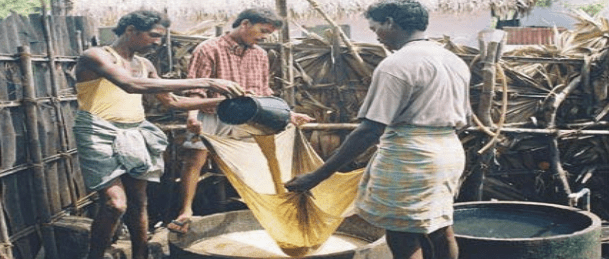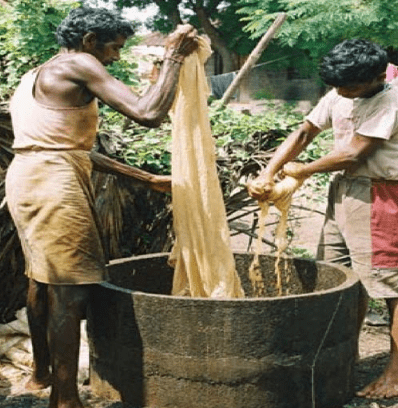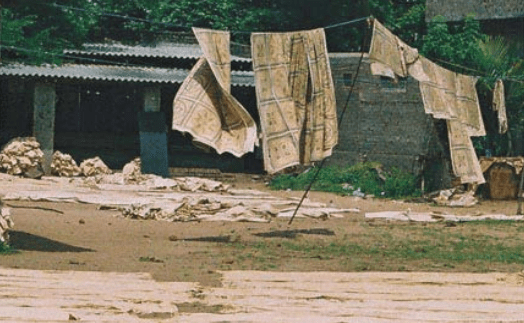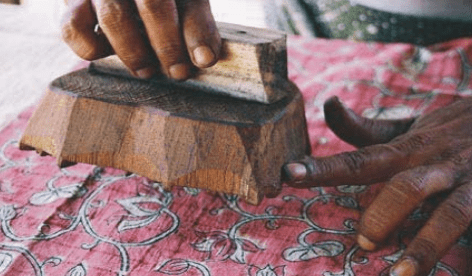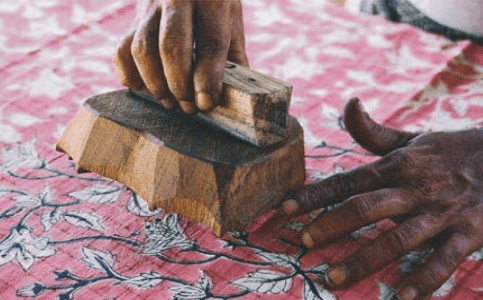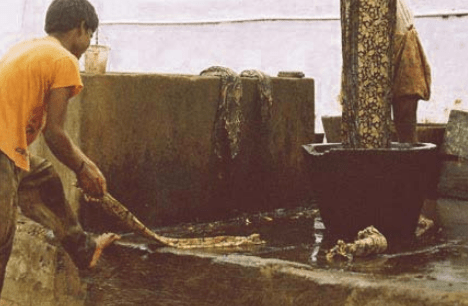Kalamkari is the craft of painting and printing on fabrics. It derives its name from kalam or pen with which the patterns are traced. It is an art form that was developed both for decoration and religious ornamentation.
Step by Step making of kalamkari Design Sarees
History
The discovery of a resist-dyed piece of cloth on a silver vase at the ancient site of Harappa confirms that the tradition of Kalamkari is very old. Even the ancient Buddhist Chaitya Viharas were decorated with Kalamkari cloth. Little was known about printed Indian cotton before the archeological findings at Fostat, near Cairo.
The discovery unearthed a hoard of fragments of printed Indian cotton supposed to have been exported in the 18thcentury from the western shores of India. As tudy of some of these Fost at finds in 1938 by Pfisher, who traced them to India, brought to light evidence of a tradition of those fabrics that were actually block printed and resist-dyed with indigo.
Before the artificial synthesis of indigo and alizerine into dye stuffs, blues and reds were traditionally extracted from the plant indigofera tinctoria and rubia tinctoria. alizerine, commonly used as a coloring agent, was found in ancient times in madder.
The madder root, rubia, widely used in India and chay(chay is oldenlandia),the root of oldenlandia umbellata, were highly estimated as fine sources of red in the south. The dye roots of morinda citrifolia linn and morinda tintoria known as alizerine or cirang were found in southern, western and central India. These were the main sources of traditional Indian dyes.
Regions:
In Andhra Pradesh, Kalamkari block printing is done in Machlipatnam. The main places are Pedana, Kappaladoddi, Polavaram and many other small nearby villages. These places are famous for their Kalamkari fabrics and furnishings.
Producer Communities
The main castes engaged in Kalamkari work in Andhra Pradesh are the Devangas, Padmasalis, Kannebhaktulu and Senapathalu. These community groups weave as well as do the dyeing and printing. The dyers and printers who did their respective jobs belonged to the Hindu or Muslim faiths.
The blocks for printing were made by specialist block makers, but sometimes the printers also made their own blocks. Apart from Andhra, Kalamkari is also found in Rajasthan and Gujarat. But their Kalamkari can be easily differentiated on the basis of design, fabric and dyes.
Raw Materials
1. The base on which Kalamkari printing and dyeing is carried out on is kora(unbleached) long cloth of 20 or 60 counts. Hence it forms the chief material constituting the Kalamkari fabric.
2. Dyes–They are described in detail in the process.
3. Beeswax
4. Fuel
5. Cow dung used for bleaching process
6. Buffalo milk
7. Water
Tools
1) A workbench which is 63 inches long, 27inches wide and 18 inches high, to enable the worker to squat by its side and attend to the block printing work, is required.
2) A three-legged low table 45 inches x 12 inches x 18 inches for wax processing and other dyeing is required.
3) Printing blocks
4) Stamping pads to hold the dye for block printing
5) Kalams
6) Dyeing vat
7) Broken pots for melting wax
8) Larger copper pots for boiling
Stages of the Production Process
The following are the main stages in the production process:
1. Block making/Preparation of the Kalam
2. Initial preparation of cloth for Kalamkari process
3. Formulation of starch
4. Mordanting of cloth in myrobalan solution
5. Outline block printing
6. Filling in colors, printing pads
7. Bleaching and washing
8. Starching
9. Degumming and washing
10. Cleaning of the cloth and application of alum solution
11. Soaping and finishing (Final process)
Elaboration of the Dyeing Processes
The process of dyeing or printing with natural dyes depends to a large extent on the use of mordants. A mordant is a substance that has the affinity for both fiber and dyestuff and which fixes the color on the material.
Preparation of Mordants:
Iron Acetate and Alum Iron Acetate (Kasim in Telugu)
Iron acetate is used for obtaining the black color on the fabric. The proportion of the ingredients used is 36 liters of salt water, 12 kilograms of jaggery, 21kilograms of iron strips and 1 sack of paddy husk.
Paddy husk and iron strips are piled in alternative layers and set aflame with charcoal and cow dung cakes. This is allowed to smolder through the night. The following morning the iron strips are retrieved, washed and scrubbed with stone to remove the rust.
The cleaned strips are placed in a barrel-shaped stone pot. A solution of jaggery and salt water (well water) is made and poured on to the iron fillings. The stone pot should be securely covered and should be 90 per cent below the ground level.
Alum (Karam in Telugu)
Dry alum crystals are pounded to powder. Water is added in the proportion of 4 liters water to 3.5 kilograms alum. The solution is allowed to boil with occasional stirring until it has reduced to half. A mixture of iron in any form leads to darkening of the color and for this reason the iron implements and utensils are avoided.
Preparation of Myrobalan solution:
This is prepared from the dried flowers called karakkaya (in Telugu) or myrobalan. The flowers are put into a stone pot and pounded with a wooden rod. Water is added to the powdered karakkaya and the solution is boiled for at least 2.5hours. The liquid is stirred during the process. After it has cooled, it is filtered and kept ready.
Preparation of dyes
Obtaining yellow color dye:
For a very light yellow even anar or danimma is used. Rice is cooked in a cauldron until it becomes a shapeless mass. The liquid is then filtered into another vessel.
While the gruel is being strained, hot paddy juice is also poured in. The solution is allowed to cool for about half an hour. Buffalo milk in the proportion of5 liters to 6 kilograms rice is stirred in this which provides added stiffness to starch and helps it to spread evenly. The starch is particularly used during the painting of the color yellow.
Obtaining red, indigo, orange and green color dyes:
Red is obtained by using alum as the mordant and then boiling the alum-printed fabric in alizerine. Indigo is obtained from indigo cakes. It is mixed with rice starch and not gum for printing purposes.
All other colors are obtained by mixing them with gum. Orange can be obtained by a combination of red and yellow or by boiling the alum-printed fabric in a mixture of alizerine and moduga.
Elaboration of printing process
Bleaching
The unbleached material/cloth/gray cloth is soaked in a solution of buffalo or cow dung and water for 5 to 10 minutes. It is wrung out a little and kept wet overnight. The next morning it is washed in flowing water and spread over waterweed and dried in the sun.
Nowadays sometimes the cloth is dipped in cow dung only once as a cleansing and de-starching process rather than a bleaching process.
Application of Myrobalan
The cloth thus bleached is then soaked in a myrobalan solution. The myrobalan solution is prepared well before it is used. (The process has been described earlier.) The material is dipped into this solution, removed immediately and squeezed out and dried in the sun.
The tannin in the myrobalan plays a special role. On reaction with iron salt a black color is produced. When the tannin reacts with alum it improves the fastness of the red dye. It also helps the cotton fiber to absorb the iron and alum salts more evenly.
Tannic acid
Block Printing
The printing is done on a long wooden table. The surface of the table is covered with gunny cloth, over which a damp cloth is spread. The fabric to be printed is stretched out on the table. The damp under surface prevents the cloth from slipping during printing.
Block printing is generally carried out in two stages namely:
i) Printing of the mordants (iron acetate and alum for outline or background or motifs).
ii) Printing of the motifs
The two stages might reverse, depending on the color being used for printing. If the background were to be printed with indigo or indigo-green then the background would be printed last.
Printing of Mordants
Two mordants, namely iron acetate (kasim in Telugu) and alum (karam) are used. The printing of iron mordant precedes that of alum.
Mordant is placed in a printing pad. The basic structure for this is a rectangular tray made of teakwood. The bamboo separators act as the base over which a sponge layer is put which is further covered with a woolen or gunny cloth.
The sponge layer absorbs the mordant in a limited quantity and the woolen cloth acts as a blotter allowing only the surface residue to come in contact with the block.
First, the background of the designs is printed and then the outline of the designs is printed on the myrobalan-dipped cloth by using kasim and karam for red and other colors.
Degumming and Washing
After block printing the cloth is kept for two to three days until dried. It is washed inflowing water to remove the gum and any unwanted mordant so as to avoid development of color in any unwanted area due to spreading of the mordant. After washing for one hour, it is dried in the sun.
Boiling
An alizerine solution is made by dissolving it in cold water. A copper pot with water is placed on a brick fireplace. The alizerine solution and jajaku leaves are added to the boiling water. The jajaku leaves act as a carrier and hasten the dyeing process.
The mordant-printed fabric is then completely submerged and allowed to boil for an hour and a half. The cloth is properly swirled ensuring even permeation of alizerine. Sometimes various other leaves and flowers are added with the alizerine and put to boil according to the colors needed.
1. Water + alizerine————–Red
2. Water + alizerine + Moduga ——– Light orange
3. Water + alizerine + Anar ————Dark orange
4. Only Moduga + Water —————-Yellowish-orange
5. Water + only Myrobalan flowers – Yellow
After the red color has developed, the cloth is taken out, squeezed and dried in the sun. The amount of time for which the cloth is kept in water determines the shade of the cloth.
During the process not only the red color develops as a result of the combination of alum and alizerine but the alizerine also contributes to fixing the black color which has emerged at a previous stage. The portions not treated with alum imbibe a pinkish color. These raw materials are brought from Vijaywada in Andhra Pradesh and the alizerine is especially brought from Mumbai.
Printing of Yellow, Green and Indigo
After the above process, the second printing is carried out. This involves the printing of yellow, green, pink, gray and indigo. For yellow, the fabric is dipped in prepared starch (boiled rice water). Fresh buffalo milk is also added to the starch solution to prevent the colors from running.
Starching prevents diffusion of the yellow color by preventing undue seepage on to the reverse side. This is the only stage where a brush (made of date-palm stick) is used to apply the yellow color (prepared my robalan solution). Indigo does not require any mordant so the solution is printed directly. Green is made sometimes from mixing yellow and indigo and other times using anar or danimma.
Final Processing
The alum solution is made by adding cool water to pounded alum crystals. The fabric is then submerged in this solution for a while. The excess yellow color runs off and all the colors are fixed.
Soaping
The last stage is washing with soap after which the cloth is dried in the sun. The cloth is kept in soap water for a few minutes and then washed and dried in the sunlight. The entire process takes almost two months. Nature should also be favorable and not interrupt the process. The progress of work depends entirely on nature.
List of Products
Especially in the olden days, Kalamkari prints were used for canopies, screen cloth, prayer cloth, etc., but today their uses are diversified for different purposes.
They are used as dress material, saris, handkerchiefs, curtains, and wall and frame hangings and also for upholstery, curtains, bed sheets, pillow covers, mats, carpets, durries, caftans, bags, purses, etc. The prices of Kalamkari per meter may vary from place to place.


